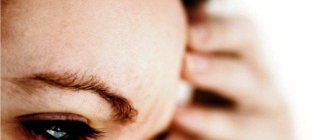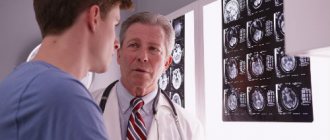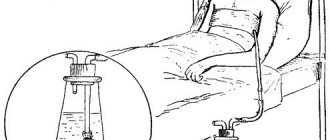Publication date: August 10, 2020
Traumatic brain injuries are a common cause of cephalalgia and other neurological disorders. Pain often indicates the development of life-threatening complications that require emergency care (including surgery). If chronicity occurs, then symptomatic treatment of headache after injury is carried out using the same techniques and drugs as for primary cephalgia.
Types of post-traumatic headaches (PTTH)
All PTTH are divided into chronic and acute. Acute pain includes pain that develops during the first two weeks after a head injury and persists for no more than two months. The chronic type of cephalalgia also appears in the first 2 weeks, but bothers the victim for a longer period. Acute PTTH is usually symptomatic. Their severity and localization are directly dependent on the nature and severity of the damage. The appearance of pain is possible in the “light interval”, i.e. with a general improvement in the first hours or days. If acute headaches occur after a head injury, treatment should begin after identifying their specific cause. A thorough examination (including fluoroscopy, CT and MRI) is mandatory to exclude brain contusion, the presence of intracranial hematomas and hemorrhages under the arachnoid membrane.
Characteristic features of PTHA against the background of subarachnoid hemorrhage are:
- high degree of severity;
- rapid development of meningeal syndrome;
- increasing pain when straining, turning or tilting the head;
- hyperthermia;
- associated nausea and vomiting.
With brain contusions, cephalalgia is more intense on the side of the injury. It tends to intensify with percussion (tapping). Important: In some cases, acute PTTH is caused by damage to the muscles of the cervical region.
Chronic post-traumatic cephalgia acquires an independent character; often they develop as a result of a relatively mild traumatic brain injury against the background of a reversible neurological defect and the absence of significant changes in the structures of the central nervous system. Such pain can haunt the victim for many months and even years, and in the long term they sometimes progress. Painful sensations can be boring, pressing or pulsating, and there is usually no clear localization. The duration of attacks ranges from several hours to 2-3 days. In particularly severe situations, pain torments the patient every day.
Degree of soft tissue damage
Most often, when a head injury occurs, a “bump” appears at the site of the impact - this is what it is called in common parlance, but there are also more pronounced injuries.
Soft tissue lesions are classified as follows:
| Soft tissue bruise | Swelling and pain develop at the site of the injury. |
| Abrasion | When struck casually, scratches form on the skin, which bleed, but not much. |
| Bruise | Due to damage to small vessels, the skin becomes saturated with blood. |
| Subcutaneous hematoma | Hemorrhage from larger vessels. The blood pushes the subcutaneous soft tissues apart and accumulates in the resulting cavity. |
| Bruised wound | As a result of the impact, the skin is cut. A wound is formed, often linear, sometimes with crushed edges. Due to the fact that the vessels on the scalp spontaneously collapse poorly, bleeding may begin. |
| scalped wound | It also occurs with a casual impact, but due to greater force and depth, detachment of the skin flap occurs. |
Any soft tissue injury may or may not be accompanied by bone or brain damage.
How to deal with post-traumatic headaches?
Treatment of acute PTTH involves taking emergency measures to eliminate the cause that caused them (elimination of hematoma, etc.). For concussions, the following medications are prescribed:
- Cerebrolysin (peptide complex to improve metabolism in nerve cells, administered intravenously);
- Mildranate or Actovegin (antioxidants for intravenous administration);
- Cavinton (a drug for improving cerebral blood flow);
- Diacarb (dehydrant to prevent cerebral edema).
If chronic post-traumatic pain develops, treatment is carried out using the same methods as for most primary headaches. One of the most important components of therapy is the psychological rehabilitation of the patient.
They very often have concomitant mental disorders - anxiety and depression. To cope with such conditions, the help of a qualified psychotherapist is required. During the recovery period, hypnotherapy and neuroprotective therapy, as well as acupuncture, are widely used. For pain that spreads from the neck to the back of the head, the doctor may prescribe physiotherapy and therapeutic exercises, as well as exercises in the swimming pool. Drug treatment is carried out in two directions - stopping attacks and preventing them. Analgesics and β-blockers are indicated to relieve pain. In many cases, vascular agents are useful in the treatment of post-traumatic headaches. With their help, microcirculation in the brain pool improves. Thanks to this, regulatory processes in the central nervous system are restored. Memory impairment and other cognitive disorders are indications for the use of nootropics in the treatment of headaches after injury. The fight against reversible mental disorders often requires the prescription of tricyclic antidepressants. They stabilize the psycho-emotional state and normalize sleep. For the treatment of acute and chronic post-traumatic pain, patients are prescribed vitamin and mineral complexes, including folic acid, B vitamins and phosphorus. Intense cephalgia, accompanied by insomnia, is an indication for taking sedatives - Dormiplant or Adaptol. Combination therapy may include manual therapy sessions. Patients suffering from chronic PTTH need to be observed by a neurologist.
The text was checked by expert doctors: Head of the socio-psychological service of the Alkoklinik MC, psychologist Yu.P. Baranova, L.A. Serova, a psychiatrist-narcologist.
CAN'T FIND THE ANSWER?
Consult a specialist
Or call: +7 (495) 798-30-80
Call! We work around the clock!
Head injury in children
A head injury in a small child most often occurs due to parental oversight. Older children hit their heads when they fall when they begin to walk. Sometimes injuries happen during games.
A peculiarity of childhood injuries is that the child is not always able to say what hurts him and how. Not all functions of his brain are formed (speech, writing, reading). Therefore, it is impossible to check the symptoms of violation of these functions, as well as to carry out some tests that are performed according to the instructions (digital, heel-knee, and others).
Due to the fact that the fontanel of the skull is not closed in young children, their intracranial pressure does not increase sharply and significantly, and the signs of intracranial hypertension are not always pronounced. All these features lead to the fact that diagnosing a concussion in a child is difficult, and manifestations can be minimal even with severe damage.
If a child falls and hits his head, but there are no visible injuries, then you need to pay attention to the following symptoms:
- the child cries for a long time;
- vomiting occurred;
- he became drowsy;
- holds his head unnaturally;
- stopped fixating his gaze or asymmetry of the eyes and face appeared;
- there was loss of consciousness (even short-term).
In general, for any head injury in a child, especially a small one, you should consult a doctor. If for some reason this is not possible, you need to watch the baby especially closely for the first 24 hours. It is even recommended to wake him up periodically to assess whether his lethargy and other symptoms are increasing.
Diagnostics
A head injury requires clarification - what changes have occurred in the soft tissues, skull bones and brain matter.
Therefore, when visiting a doctor, the following diagnostic measures are carried out:
- Clarification of complaints - where it hurts, how it hurts, if there is dizziness, weakness in the limbs and other manifestations.
- Taking an anamnesis - the circumstances of the injury are clarified (where the blow was, what force, what object), what happened immediately after the blow (loss of consciousness, vomiting), how the condition has changed over time, whether treatment was carried out and with what effect.
- Inspection of the injury site.
- General examination , allowing to assess the patient’s condition, measuring blood pressure, pulse and other indicators.
- Assessment of neurological status - the presence of general symptoms indicating brain damage and signs of loss of one or another of its functions.
- Laboratory and instrumental studies - radiography of the skull bones, echo-encephalography, analysis of cerebrospinal fluid.
This is a standard list of activities; if necessary, it is expanded or reduced. For example, if there is a wound on the head under a bandage, an x-ray is immediately performed, and the wound is inspected during the operation. And if a hematoma is suspected, an MRI or CT scan is additionally performed.
First aid at home and when to go to hospital
The most important condition for a head injury is rest. If a person has fallen and does not move, he should not be disturbed so as not to aggravate the situation. It is necessary to assess his condition and well-being on the spot, and only if it does not cause serious concern, then the patient can be allowed to move.
If there is loss of consciousness, vomiting or dizziness, you need to call an ambulance. You should also consult a doctor if the headache does not go away for a long time, weakness or drowsiness increases, or other complaints persist. It is not recommended to go to the doctor on your own.
If you hit your head, the first thing you need to do is apply a cold compress.
The arriving medical team will conduct an on-site examination, make a preliminary diagnosis and provide assistance. If hospitalization is necessary, they will accompany the patient to the medical facility.
Before the team arrives, you can apply cold to the bruise - ice from the refrigerator or, if there is no ice, any frozen product in a bag. The ice must be wrapped in a towel to prevent hypothermia. Under the influence of cold, blood vessels contract, bleeding decreases (externally and in the tissue), and the development of edema is prevented.
If there is a deep abrasion or wound, you should also consult a doctor. You may need to get a tetanus shot. It is better not to treat the impact site at home with anything. The wound should be covered with a sterile napkin or a clean cloth, ironed, and lightly pressed to stop the bleeding. Under no circumstances should you apply too much pressure, so as not to displace bone fragments if there is a fracture.
Complications and consequences of injury
A complication of a head injury can be injury to the skull, brain, or cervical spine.
Even with proper treatment, sometimes consequences remain:
- weather sensitivity;
- mental manifestations, for example, in the form of emotional lability;
- decreased memory and thinking abilities;
- headache;
- insomnia;
- periodic dizziness;
- intracranial hypertension.
Severe injuries that damage brain matter may result in complete loss or impairment of function associated with that area of the brain, such as limb weakness, hearing loss, or speech impairment.










